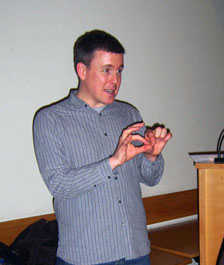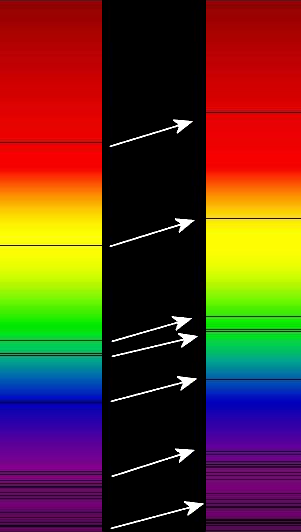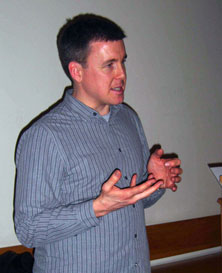
|
Flamsteed Astronomy Society |
|
‘Cosmic Explosions, Dark Energy and the Fate of the Universe’ by Dr Mark Sullivan - February 13, 2012 |
|
page 1 of 3 |

|
Report by Chris Sutcliffe At the beginning of the meeting some important announcements were made. David Waugh mentioned the formation of a Radio Astronomy Group, details of which would follow in the near future. As Mike Dryland is leaving the committee, Mike Meynell has been appointed as vice-chair in addition to his existing responsibility for the website, social media and observation coordinator. Sumitra spoke about the new Flamsteed Facebook and Flickr sites. Facebook includes details on forthcoming events, meeting write-ups and astronomy news. Flickr features astrophotography and anyone can submit photos if they set up an account. Details on camera settings for many of the photographs can be viewed. There also is a discussion board where questions can be asked and answered by members. Jane then introduced Dr Mark Sullivan who is a Royal Society University Research Fellow at the University of Oxford. He first introduced the subject of the accelerating universe. The universe appears static based on our visual observations. For example, the Hubble deep field image is only a fraction of the size of the full moon, with every object being a galaxy billions of miles away; but in 100 years, they will still all look the same. However, they are moving away from each other at huge speed and the universe is expanding with time. In 1915, Einstein developed general relativity, one of the most successful theories ever developed. Einstein preferred a static model of the universe, in which space is neither expanding nor contracting, and he added a cosmological constant to his equations of general relativity to counteract gravity. He later called this his 'biggest blunder', after the discovery of an expanding universe. Slipher in 1915-1917, and Hubble in 1929 observed the Doppler shift when observing distant galaxies. They noted that when light is passed through a spectroscope, the resulting spectrum includes dark absorption lines caused by the chemical elements in the galaxy. If there is a shift of lines to the red (redshift), the galaxy is moving away; if there is shift of lines to the blue (blueshift), the galaxy is moving towards us. Slipher noted that most galaxies have redshift, and few have blueshift; therefore galaxies are moving away from us. Hubble discovered a rough proportionality of the distances of objects with their redshifts. Mark then explained measuring distance using the standard candle technique illustrating this with the light from a supernova explosion reaching an observer on Earth. An object which is half the distance appears four times as bright and therefore if the you measure an object’s apparent brightness, you can determine the distance. The most distant galaxies are moving away from us at faster speeds and Dr Mark presented a graph showing recession velocity in km per second against distance. Clearly, the universe is expanding.
Continued/ |

|
Dr Mark Sullivan [Pic Dr Francisco Diego] |
|
Dr Mark Sullivan [Pic Dr Francisco Diego] |


|
Absorption lines in the optical spectra of distant galaxies (right) compared to the absorption spectrum of the Sun (left). Arrows indicate redshift. |
